Mobile CPU Wars: Core 2 Duo vs. Core Duo
by Anand Lal Shimpi on August 3, 2006 9:25 AM EST- Posted in
- CPUs
Application Performance using SYSMark 2004 SE
We'll kick off our look at general application performance with SYSMark 2004 SE as always, and we'll look at the overall score as well as the scores in each of the two suites - Internet Content Creation and Office productivity.
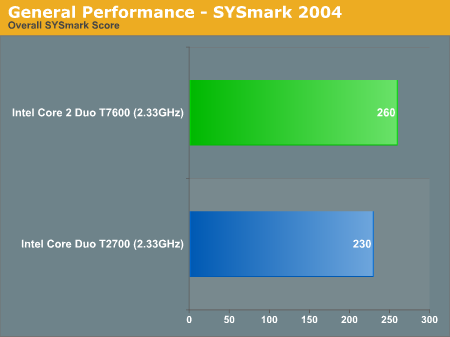
Clock-for-clock, Intel's Core 2 Duo is able to outperform its predecessor by 13% according to SYSMark 2004 SE's overall score. While the performance advantage isn't as dramatic as what we've seen on the desktop, comparing Core 2 to Pentium D, at 13% we're still looking at a performance gain that is noticeable in real world usage.
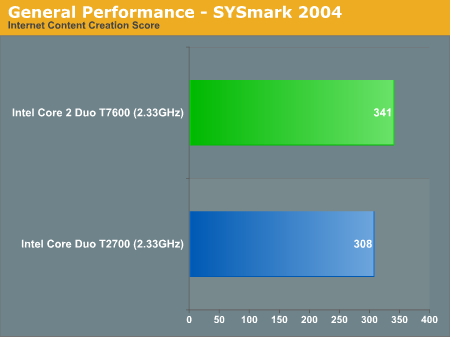
Drilling deeper and looking at the overall Internet Content Creation score, Core 2 Duo's performance advantage drops slightly to 10.7%. The performance increases we're seeing here highlight one very important point in current CPU architecture innovation. We're looking at a 10% increase in performance here, yet it required a 93% increase in transistor count to achieve (mostly because of the larger L2 cache, 4MB vs. 2MB). AMD and Intel are both looking to multi-core solutions to deliver better performance-per-transistor efficiency, rather than simply throwing more clock speed and cache at the problem.
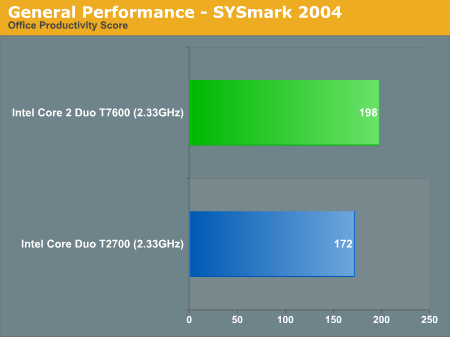
Speaking of the impacts of a larger L2 cache, we may be seeing those here in the Office Productivity suite where Core 2 Duo holds a 15.1% lead over Core Duo. The advantage is large enough to be noticeable, and definitely appreciated when you look at the fact that the Core 2 Duo we're benchmarking here has the same MSRP as its Core Duo predecessor.
The performance increases also come from the modified pipeline and internals, but we will have to get ahold of a 2MB Merom chip to determine exactly how much of the improvement comes from the added cache and how much comes from the reworked architecture.
The breakdown of SYSMark 2004 SE tests are below:


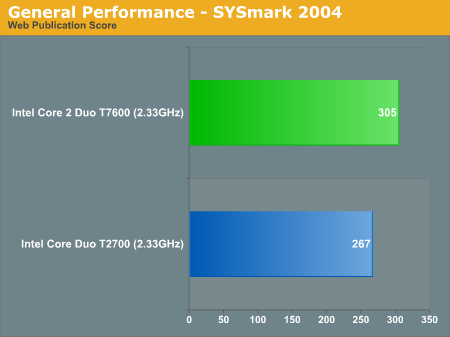

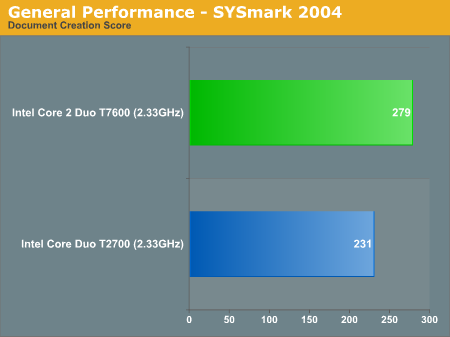











46 Comments
View All Comments
Sergio710 - Thursday, August 3, 2006 - link
I've heard that Merom would come to 45 nm some day, does anyone know more about it ?supposed date ?
impact on battery life ?
mino - Thursday, August 3, 2006 - link
All CPU series wiil go 45nm. Eventually.AFAIK don't expect 45nm Core 2's sooner that Q108.
Sergio710 - Thursday, August 3, 2006 - link
Forgive my ignorance, but what benefit will have 64 bits for every day use ?better performances on Vista or enabled soiftware or only the possibility to install more RAM ?
LoneWolf15 - Friday, August 4, 2006 - link
Longevity will be the benefit.It's not helpful right now, but if you're like me, you'd keep a notebook computer for some time before getting rid of it. I buy as future-proof (since that isn't possible, future-resistant) as I can. That means I'd want a 64-bit capable processor so that I can run the 64-bit version of Vista at some point, and so that I have the option of going to 4GB of RAM on my notebook some day. Since Merom prices are the equivalent of Yonah prices, this makes even more sense --it wouldn't cost me any more.
Pandaren - Thursday, August 3, 2006 - link
Right now, there is no benefit. Unless you are running Linux. 64-bit is completely useless for most people until Microsoft gets it together and finishes Windows Vista.peternelson - Thursday, August 3, 2006 - link
I agree I was thinking of 64 bit linux and technical apps like rendering.However there is possible option on XP64 professional. eg if you want to do trial factoring for mersenne.org prime number project, running the 64 bit client gives a big boost over 32 bit version.
I hope 64 bit becomes more mainstream (not just nerds) when Vista 64 is available.
In ideal world: boot linux64 and Vista64 or virtualise one with the other.
As a bonus if you can throw in a 64 bit version of a new Mac OS for a triple OS environment, that would be just what the doctor ordered.
At the moment I can live without the Apple support, so linux/vista will be fine. ie Linux for serious work, Vista for 3D gaming.
jeffwegher - Thursday, August 3, 2006 - link
Isn't another advantage of the new Merom that it's 64-bit whereas the older Yonah is only 32-bit?peternelson - Thursday, August 3, 2006 - link
He stole my comment, but ABSOLUTELY.A major disadvantage of Core Solo and Duo (as in Yonah) was that it's 32 bit ONLY.
For that reason I won't buy a laptop or apple mac based around it.
Merom (Core 2 Duo) IS 64 bit capable and that's important to me. It's the MOST important feature of this upgrade, second most important is virtualisation.
I hope Apple wake up and start sticking Meroms into their desktop and notebook macs real soon.
Also anandtech you don't mention that very point, using a so-called mobile cpu in a desktop SFF which is a market predicted to grow.
This has to be another big market for Merom cpu: space saving home systems, media centres etc.
As for all the hype about how much better this new generation architecture is, I have to say the performance jump of 2-5-10-15-20% is mediocre compared to what might have been expected if the reality lived up to the hype. Thanks anandtech for setting the record straight. On the other hand ANY performance increase for no extra battery usage has to be welcome. You're right that the FSB constraint limits it in today's machines.
It's good they are priced similarly although in the market I expect manufacturers to charge a premium in the short term.
How quickly will Apple be adopting this in their small desktop machines?
IntelUser2000 - Saturday, August 5, 2006 - link
Actually you are in your own reality to expect greater advantage than that over Core Duo. If you have been actually paying attention, Intel expects 20% advantage for Core 2 Duo 2.33GHz over Core Duo 2.167GHz. Core 2 Duo's performance advantage of 40% applies against Pentium D, which is worse performer than Core Duo.
Not to mention Core 2 Duo in Laptop has same FSB, same memory, same chipset as Core Duo!!
Pandaren - Thursday, August 3, 2006 - link
Intel claimed all along a 40% performance jump relative to Pentium D, NOT Core Duo. The performance jump relative to Core Duo was always claimed as "up to 20%," which is in line with Anandtech's findings.